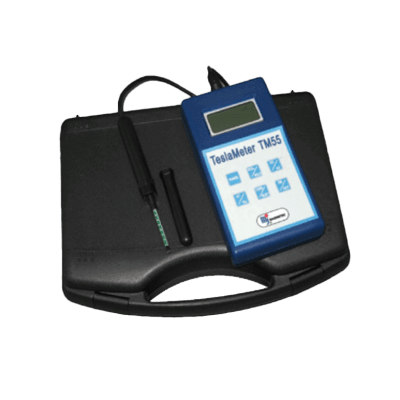What Is a Tesla Meter?

A Tesla Meter is an instrument for measuring the magnetic field (magnetic flux density) in a space. It measures the magnetic flux density per unit area.
Tesla Meters display the magnetic flux density in units of gauss or tesla using the Hall effect, an electrical property of semiconductors.
Generally, the stationary type has high accuracy and resolution, and can measure even in strong magnetic fields. They are used to verify the strength of magnetic fields not only in R&D and academic applications, but also in manufacturing and quality assurance.
Uses of Tesla Meter
Tesla Meters are used to verify the strength of magnetic fields not only in R&D and academic applications, but also in manufacturing and quality assurance. For example, Tesla Meter is used to measure powerful electromagnets (~10T) used in accelerator facilities.
Another application is in product quality control, where measurements are made to determine the magnetism of magnetic flux leakage, or the properties of magnetic materials.
Furthermore, it is also useful for measuring geomagnetism, since the earth also maintains a magnetic field (~nT), albeit a weak one.
The appropriate instrument should be selected according to the magnitude and type of the magnetic field to be measured and the required accuracy.
Principle of Tesla Meter
The principle of the Tesla Meter is to measure magnetic fields using the Hall effect. The Hall effect is a phenomenon in which an electric field is generated in a direction perpendicular to the current flowing through a semiconductor when a magnetic field is applied perpendicular to the current and the magnetic field.
An element called a Hall element is used as a probe to measure the magnetic field. There are two types: transverse and axial.
The transverse type measures the magnetic field perpendicular to a flat plate. Since it is a thin plate, the magnetic field can be measured by inserting the probe even if there is only a narrow gap.
The axial type, on the other hand, measures the magnetic field perpendicular to the probe end face. It can be inserted into a small solenoid coil, for example, to measure the internal magnetic field.
Using these probes, it is important to evaluate the magnetic field accurately considering the angle between the probe and the magnetic field to be measured, the distance between the probe and the object, and the size of the object.
In addition, Hall element characteristics are temperature dependent. Therefore, care must be taken when making measurements in environments where the temperature changes, such as in high-temperature environments. In general, measurements with Hall elements require the use of a constant-temperature device to maintain the element at a constant temperature.
Types of Tesla Meters
There are various types of Tesla Meter depending on the application.
1. Handy Type
The most common type is the handy Tesla Meter, which is both AC and DC. They are widely used for field work, etc., because they are easy to operate and carry.
2. Stationary Type
There are large size tesla meters for high magnetic field measurement and high-sensitivity micro tesla meters for micro magnetic field measurement. Tesla Meters for high-sensitivity micro magnetic field measurement are especially used for measurement of the earth’s magnetic field.
3. 3-Axis Tesla Meter
There are also 3-D Tesla Meters for measuring magnetic field distribution. 3-D Tesla Meters use a combination of multiple probes to enable high-precision measurement of magnetic field distribution within a 3-dimensional space. They are often used in the medical field and materials development.
4. Superconducting Quantum Interference Device Tesla Meter
A Tesla Meter, which utilizes a superconducting quantum interference device capable of measuring magnetic fields with high precision and high speed, is under development. Superconducting quantum interference elements have a higher measurement speed than conventional Hall elements and can measure magnetic fields with higher sensitivity.
How to Select a Tesla Meter
The following factors should be considered when choosing a Tesla Meter:
1. Size of the Magnetic Field
Depending on the size of the magnetic field to be measured and the size of the magnetic field you wish to measure, you need to select a Tesla Meter with an appropriate measurement range. For measuring large magnetic fields, a stationary Tesla Meter with high accuracy and high measurement range is suitable.
2. Measurement Accuracy
Measurement accuracy should be selected according to the size of the magnetic field to be measured and the application. If the magnetic field is very weak, a Tesla Meter with high resolution is required.
3. Measurement Environment
The type of Tesla Meter to be selected depends on the environment in which the Tesla Meter will be used. For example, if measurements are to be made at high or low temperatures or in a high vacuum environment, a Tesla Meter that can withstand these conditions should be selected.